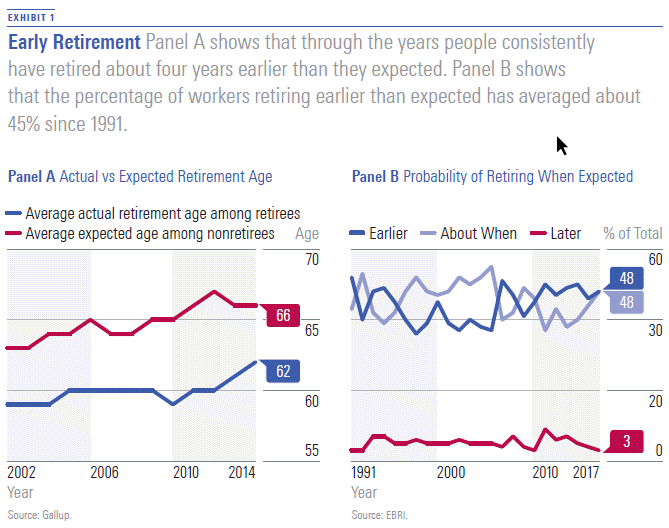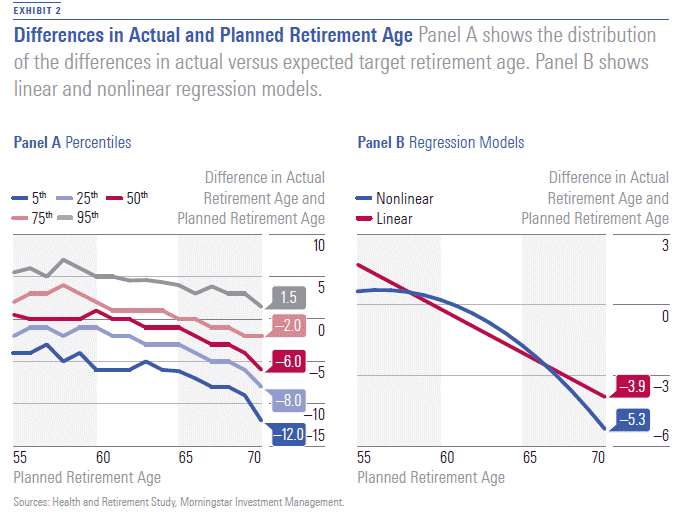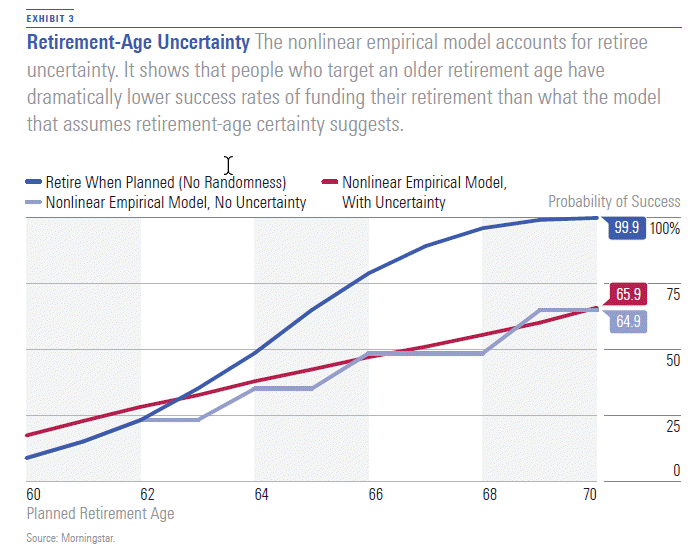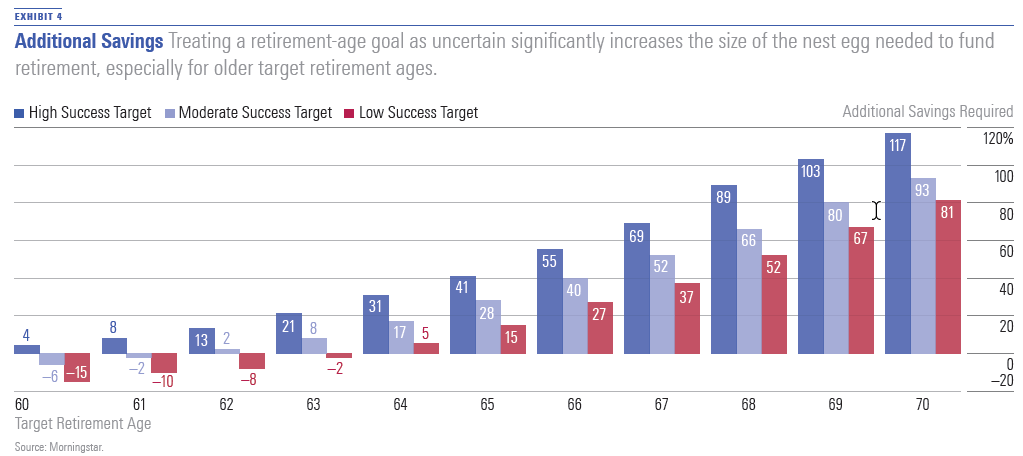When Retirement Expectations Meet Reality
Advisors should assume clients will retire earlier than they expect.
The age at which an investor plans to retire is an important assumption in any financial plan. While the retirement age is typically provided by the client and treated as certain, a significant amount of uncertainty surrounds the actual date of retirement. For example, a growing body of research says that people tend to retire earlier than they expect. Retiring earlier than expected can be significantly detrimental to an investor’s likelihood of meeting his or her retirement income goal. It reduces the time for saving and investing, lowers the Social Security benefit, and potentially adds years to the retirement period, requiring more funding.
In this article, we explore the relation between investors’ expected retirement age and the actual age they retire at. We find that while the expected age of retirement is strongly related to when the person actually retires, there are notable differences between the expected retirement ages. For example, individuals who say they will retire before age 61 tend to retire later than they expected. Those who target a retirement age of 61 tend to retire when expected. And finally, investors who want to retire after age 61 generally retire a half-year early for each additional year of work they plan past age 61. In other words, expect an individual targeting to retire at age 69 to actually retire around age 65.
Incorporating retirement-age uncertainty can significantly affect retirement savings levels. For example, a 55-year-old worker targeting a retirement age of 65 will likely retire a couple of years earlier. With a 4% initial withdrawal rate, the worker would need approximately 25% more savings (at age 55) to achieve the same income level during retirement with the same probability of success (assuming no variability around retirement age). Additional required savings can exceed 50%, or even 100%, for some scenarios.
This research suggests retirement-age uncertainty is an important consideration for financial planners, who should at least consider modeling early retirement to prepare clients for the possibility that it may occur. This is especially true for individuals targeting a retirement age past age 65.
Retirement-Age Trends In theory, a person should have a good idea of when he or she will retire. In reality, a growing body of research demonstrates that people not only do not retire when they expect, they retire earlier. This effect is noted in Exhibit 1. Panel A includes data on actual versus expected retirement age (from Gallup surveys). Panel B includes historical data on the probability of retiring when expected from EBRI's 2017 Retirement Confidence Survey (Greenwald, Copeland, and VanDerhei, 2017).

Both panels in Exhibit 1 suggest individuals retire earlier than expected. For example, in Panel A, the average difference between actual and expected retirement has been approximately four years. Although the average actual retirement age has been increasing (from 59 to 62), so too has the expected age (from 63 to 66). This is similar to the results noted in the EBRI Retirement Confidence Survey, where the median expected retirement age among workers was 65 and the actual age among retirees of was 62.
n Panel B, the percentage of workers retiring earlier than expected has averaged approximately 45% since 1991, versus 50% retiring about when expected, and only 5% retiring later than planned. Greenwald, Copeland, and VanDerhei (2017) notes that most of those who retired early tended to cite health problems or disability, downsizing or closure, or caring for a family member as a reason to retire early, while a lucky few were able to afford an earlier retirement or wanted to do something else.
Increasing retirement ages is a relatively recent phenomenon. Workforce participation of men aged 65 and older has decreased from 75% in 1880 to approximately 20% by 1980, but it’s begun to slowly creep back up (Munnell 2015). The average retirement age for men in 1962 was approximately 65, dropping to 62 in the 1990s, and increasing back to 64 by 2013 (Munnell 2015).
The trend toward later retirement age is a global phenomenon. For example, among the 34 countries in the Organization for Economic Cooperation and Development, the average retirement age for men in 1949 was 64.3 years, decreasing to 62.4 years in 1999, and then increasing to 64.2 years in 2012 (OECD 2013). This recent increase has corresponded to increases in the eligibility for government pensions along with financial incentives to delay retirement.
How Actual Retirement Age Differs To explore how actual retirement age differs from expectations, we obtained data from the first 12 survey years of the Health and Retirement Study, from 1992 to 2014. The HRS is a panel household survey focused on the study of retirement and health among individuals over the age of 50 in the United States. The HRS is sponsored by the National Institute on Aging and the Social Security Administration, and it is conducted by the University of Michigan. Respondents are resurveyed every other year, with additional households added to the survey to keep it representative of the target population. HRS fields are combined with data from the RAND HRS, which is a user-friendly version of a subset of the HRS developed at the RAND Center for the Study of Aging with funding from the National Institute on Aging and the Social Security Administration.
The HRS has detailed information about household retirement expectations and decisions. For this article, we focus solely on the relation between expected retirement age and actual retirement age. In our full paper1 (upon which this article is based), we explore other household attributes, although relatively few are statistically significant.
Exhibit 2 includes information about the distribution of differences in actual and planned retirement ages by age (Panel A) and some trends created using linear and nonlinear regression models (Panel B). The exhibit demonstrates that the error in actual and planned retirement ages is nonlinear. Investors targeting a retirement before age 61 tend to retire later than expected. For example, a worker targeting to retire at age 57 will actually retire around age 58. Those targeting a retirement age of 61 tend to retire approximately at that age. Finally, those workers targeting retirement after age 61 generally retire approximately a half a year early for each additional year planned to work past age 61.

These differences are an important distinction for advisors to consider, because the implications of retiring earlier than expected predominantly affect people with older target retirement ages (especially past age 65, given the fact that these are retirees who are actually retiring before their expected retirement age).
Impact of Retirement-Age Uncertainty on Savings Early retirement, especially the uncertainty surrounding it, can have significant implications on required retirement savings. This section attempts to quantify the costs associated with this uncertainty. Using certain assumptions,2 we tested the traditional approach financial planners use to generate a client plan against approaches that incorporate the probability of retiring earlier than expected (following the nonlinear path discussed above).
For the first approach, the retirement age is assumed to happen with certainty. The second approach incorporates potential randomness around the actual retirement age. The randomness is assumed to follow a normal distribution with a mean of zero and a standard deviation of three years. The maximum positive change in retirement age is two standard deviations (six years), although Social Security benefits are always assumed to commence no later than age 70 (and never before age 62). The maximum negative change in retirement age is also two standard deviations (six years) or the current age of the investor (for example, a 55-year-old targeting a retirement age of 60 could retire no earlier than age 55).
Exhibit 3 includes the results from simulations where the base annual retirement need is assumed to be $50,000 (in constant real dollars). The amount is not assumed to change based on retirement age. The amount represents a median withdrawal of 3.7% from the portfolio in the first year of retirement at age 65.

The exhibit contains a variety of useful information. First, delaying retirement can have a significant, positive impact on the probability of an investor achieving a financial retirement goal. Delaying retirement gives the investor more time to save, more time for the portfolio to grow, a larger Social Security retirement benefit, and a shorter retirement period (retirement is assumed to end at age 95 regardless of retirement age).
Second, incorporating average retiree behaviors (in other words, the nonlinear empirical model) results in higher success rates for individuals targeting a younger retirement age (those targeting a retirement age at 60), because these retirees tend to retire later than expected, but lower success rates for those targeting an older retirement age, because they tend to retire earlier than expected.
Next, we conducted an analysis to determine the additional savings required to achieve the same probability of success for a given withdrawal rate when incorporating retirement-age uncertainty versus more traditional retirement modeling. This is determined through stochastic simulation (in which we tested different current savings levels until the one that results in the same probability of success is determined). For example, assuming a retiree is targeting a retirement age of 65 and a 4% median initial withdrawal rate (across simulations), the total retirement need (at age 65) would be $52,076.3 The probability of success of achieving this income level (to age 95) is 56%. To achieve the same probability of success (56%) for the same income level ($52,076), the current balance at age 55 would need to increase by 28% to $641,450 (from the assumed portfolio of $500,000).
This analysis is conducted for retirement ages from 60 to 70, in one-year increments, and for initial withdrawal rates (at the target retirement age) of 3%, 4%, and 5%. To make the results more intuitive, we note that the 3% initial withdrawal target has a high probability of success, 4% initial withdrawal a moderate probability of success, and the 5% initial withdrawal target a low probability of success. The results are included in Exhibit 4.

Implications of Uncertainty Incorporating retirement-age uncertainty can significantly increase the required savings levels, especially for individuals targeting later retirement ages and with a higher target probability of success (in other words, a retiree who would take a 3% initial withdrawal). If the "average investor" is assumed to be seeking a 4% initial withdrawal rate (a moderate success target) and wants to retire at age 65, the impact of retirement-age uncertainty would require approximately 25%4 more savings than suggested by traditional models.
These results suggest ignoring retirement-age uncertainty can have a significant negative impact on retirement outcomes. While financial planners are increasingly treating returns as a random variable in financial plans (through a Monte Carlo simulation), other key assumptions also carry a good deal of uncertainty. It is essential that financial planners understand the implications associated with the expected retirement-age assumption.
References Greenwald, L., Copeland, C., & VanDerhei, J. 2017. "The 2017 Retirement Confidence Survey—Many Workers Lack Retirement Confidence and Feel Stressed About Retirement Preparations," EBRI Issue Brief, No. 431 (Employee Benefit Research Institute, March 21).
Munnell, A.H. 2015. “The Average Retirement Age- An Update,” Center for Retirement Research, March, No. 15-4.
OECD. 2013. “Pensions at a Glance.” Pensions at a Glance 2013: OECD and G20 Indicators, OECD Publishing.
RAND HRS Data, Version P. 2016. Produced by the RAND Center for the Study of Aging, with funding from the National Institute on Aging and the Social Security Administration. Santa Monica, CA (August).
1 Blanchett, D.M. 2018. “The Impact of Retirement Age Uncertainty on Retirement Outcomes.” Journal of Financial Planning, Vol. 31, No. 9, PP. 36–45.
2 See the full paper for complete list of assumptions
3 Note, $26,000 of this would be covered from Social Security retirement benefits, so the remainder ($26,076) would need to be funded by the portfolio, which has a median value of $652,147 at retirement (before withdrawals begin). This results in a 4% initial withdrawal rate ($26,076 /$652,147 = 4%).
4 28.29% to be exact
This article originally appeared in the Winter 2019 issue of Morningstar magazine. To learn more about Morningstar magazine, please visit our corporate website.

/s3.amazonaws.com/arc-authors/morningstar/951e122c-7299-4252-bafb-80cfefb25764.jpg)
/cloudfront-us-east-1.images.arcpublishing.com/morningstar/U772OYJK4ZEKTPVEYHRTV4WRVM.png)
/cloudfront-us-east-1.images.arcpublishing.com/morningstar/O26WRUD25T72CBHU6ONJ676P24.png)
/cloudfront-us-east-1.images.arcpublishing.com/morningstar/WDFTRL6URNGHXPS3HJKPTTEHHU.png)
:quality(80)/s3.amazonaws.com/arc-authors/morningstar/951e122c-7299-4252-bafb-80cfefb25764.jpg)